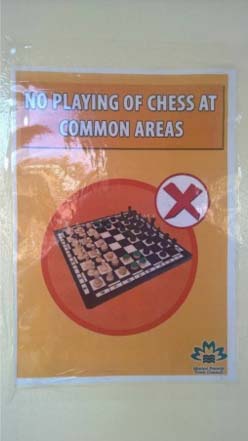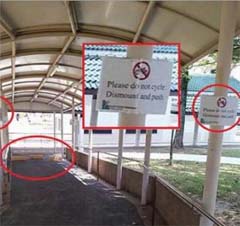 It struck many people as mindless: the notice banning the playing of chess in common areas of public housing at Block 11 Haig Road. How could playing chess in public areas be such a nuisance that it merits a heavy-handed ban? In any case, isn’t the sight of retirees playing chess in void decks a common sight all over Singapore? If they have never posed any problem, why now?
It struck many people as mindless: the notice banning the playing of chess in common areas of public housing at Block 11 Haig Road. How could playing chess in public areas be such a nuisance that it merits a heavy-handed ban? In any case, isn’t the sight of retirees playing chess in void decks a common sight all over Singapore? If they have never posed any problem, why now?
It was so indefensible that Marine Parade Town Council quickly took the notice down. But not before trying to defend it! In a Facebook post, it said,
We would like to clarify that the poster was only placed at Blk 11 Haig Road and it is not a standard poster of our Town Council.
We have received feedback from residents at the said block that the chess players are causing a nuisance and are playing till late night. In addition, the chess players and onlookers sometimes will block and obstruct the pathway of a covered linkway, causing inconveniences to others. As such, this poster seeks to advise and remind these chess players not to play their games there and to be considerate to others.
As this is a long standing issue, our Town Council has been working closely with other agencies to address it. We would also like to take this opportunity to advise users of void deck to be considerate and to lower the noise volume after 10pm.
— As reported in AsiaOne, 13 March 2016. Link.
Less than a week later, another absurdity made the rounds. I think the photo first appeared on Hardware Zone on 16 March 2016, under the title “latest dumb thing”. Said to be near Block 100 Bedok, in the Feng Shan constituency, it shows barriers put up along a walkway. This walkway appears to have been carefully inclined to serve wheelchair users, yet the barriers would obviously negate this purpose.

The original poster pointedly wrote, “and wheelchair bound how?”
Additional signs affixed to pillars close by indicate that the barriers were meant to deter cyclists from riding (and possibly accelerating) down the incline, as seen in another photo posted on Hardware Zone.
 My guess is that these yellow barriers will be removed soon. And then the furor will evaporate. Which is a pity if we do not first tease out the significance of these two incidents.
My guess is that these yellow barriers will be removed soon. And then the furor will evaporate. Which is a pity if we do not first tease out the significance of these two incidents.
It seems to me that both cases began with complaints reaching the respective Town Councils, which are headed by the local members of parliament. Maybe they even reached the MP himself or herself. However, even if a complaint did, it is unlikely that the MP would have been the one to direct how exactly to address the problem raised. It would have been delegated to a trusted lieutenant to “fix” it. Or if the complaint didn’t reach the MP, some middle-level guy in the Town Council might have tried to second-guess what the MP would have wanted (“fix it”) and took his own initiative to do it.
The quality of both decisions leave a lot to be desired. To put it more bluntly, they were dumb. They indicate a very linear approach to problem-solving, and one that is reliant on plain prohibition. They show no ability to think laterally of collateral effects such as: What about wheelchair users? or Wouldn’t that make chess-playing retirees unhappy?
Worse yet, they show complete ignorance that the reason the walkway was inclined in the very first place was so that wheelchair-bound residents could use it. You would have thought that since the Town Council was the body that first built the walkways, they’d know about that!
Another thing these examples suggest is that they were implemented by lone decision-makers, which then tells us that there is very little consultation in these Town Councils. I say this because it is really hard to believe that if there had been consultation, no one else had a single lateral thought.
One second after writing the preceding sentence, I shudder even more. Maybe there had been consultation, and indeed no one else had a single lateral thought. Everyone had the same linear robotic mode of problem-solving. Great idea, they all said, and went ahead.
Such things can happen when a group of people march in lockstep, motivated by a single unalloyed goal. The thinking process (or what passes for a thinking process) is narrowly focussed on the goal. Much weight is given to achieving that goal, and doing so quickly. Too little weight is given to balancing against other objectives. In fact, spending time mulling over pros and cons, or brainstorming alternative solutions, is not considered an asset, but a liability: it delays the achieving of the primary goal.
We now need to deduce what that primary goal was that was so important that they took these shortcuts in decision-making. What was that imperative that blinded them to collateral effects and other possible ways of addressing the complaints. Why was it so important to act quickly, almost in a kneejerk fashion?
My sense is that these are signs of political leaders surrounded by sycophants. A sycophant is someone who acts obsequiously toward someone else, often a person with rank and power, in order to gain advantage. In other words, a yes-man.
These blunders are classic example of yes-men behaviour. They try their utmost to show the boss that they are attentive to his needs and security (i.e. protecting him from constituents’ brickbats). They respond quickly to any signs of unhappiness they detect among the serfs and try to solve the problem before the “lord” gets angry or embarrassed. Speed is key. Care in the quality of decision-making is sacrificed at the altar of speed.
Another thing to note: sycophants aren’t very bright. Bright people tend to have more self-respect than be one.
How does this square with the frequent boasts of meritocracy?


The sycophant cacophony hit the highest pitch in the 2010 Asian Games’ male swimming trunks for our Singapore water polo team. I reckon that design likely went all the way to ministerial level …. good ol’ Vivian Balakrishnan at the time.